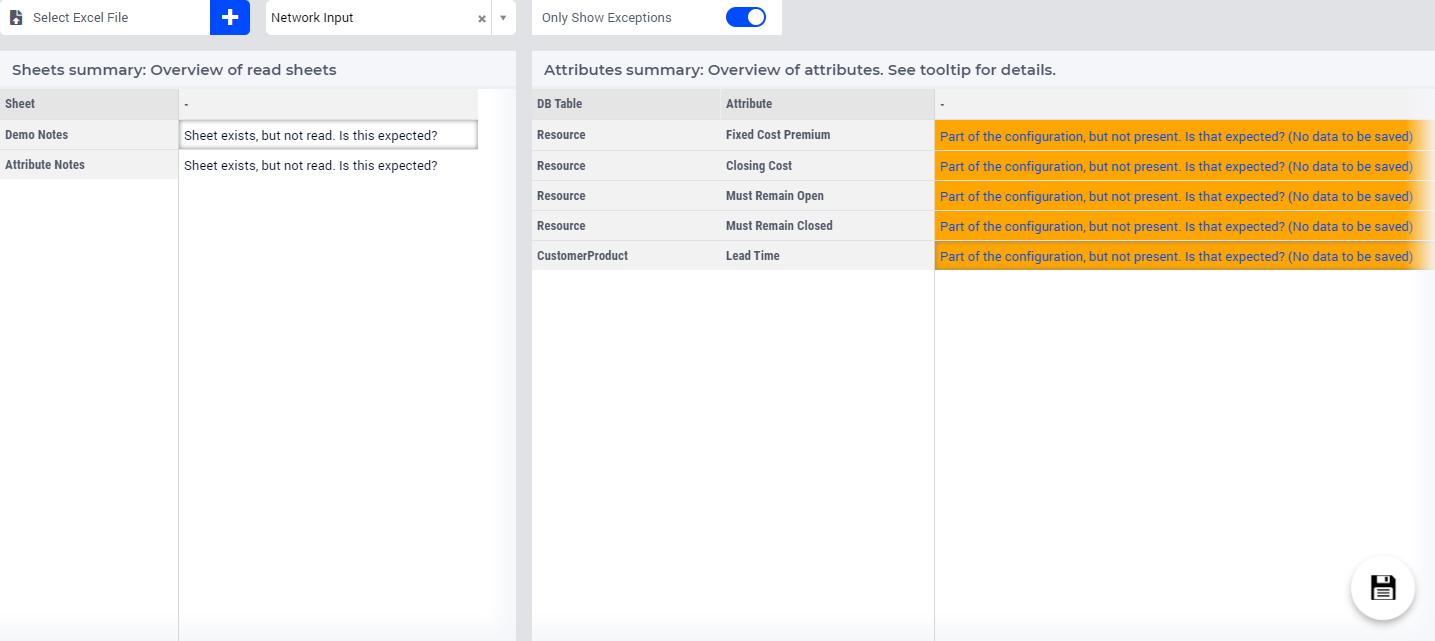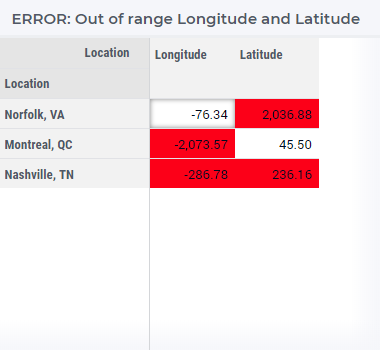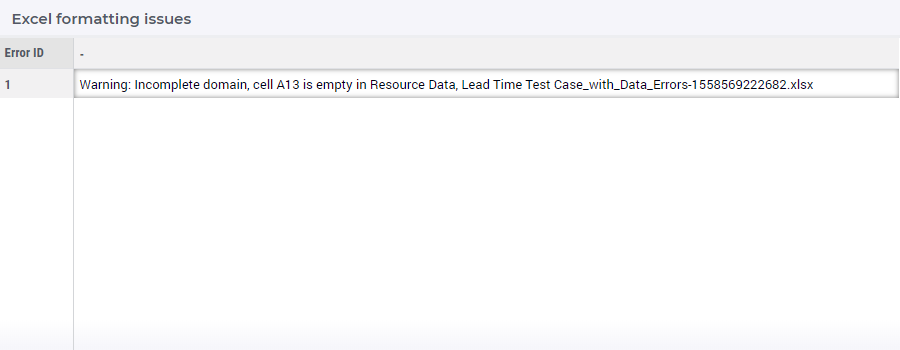Import Dataset
On the Import Data page you can import your filled data template file and save your data to the SC Navigator database.

Select Excel File
Press the  button next to “Select Excel File” and select the completed data template file in the pop-up dialog. Click
button next to “Select Excel File” and select the completed data template file in the pop-up dialog. Click  to import the file.
to import the file.
It is possible that importing data will lead to warnings. One of the warnings is of this form Attribute Variable Throughput Cost for (Food Products,Ankara_LDC,Ankara_Location,2018) has multiple (2) values for Locations groups, for which at least some are different. This means that Ankara_Location belongs to two groups, and the data is specified differently for these two groups. SC Navigator takes the highest value, but still gives a warning. It is recommended that you fix the data issue, so that you don’t have any warnings anymore.
Important
Your data will not be saved until you click the button Store data in database!
Sheet overview
In the table Overview of read sheets you’ll see a list of sheets in the Excel file. Where data was not read, the text “Sheet exists, but not read. Is this expected?” appears. For sheets containing only comments or notes, this is expected and no action is required.
If sheets where you entered data are not read, you need to debug. The most likely reason is a sheet name was entered manually and doesn’t match the expected name, or you’ve uploaded data that isn’t needed for this configuration.
Switch off Only Show Exceptions to see all the sheets from the Excel file. Sheets where you have entered data correctly have status “Sheet exists and read”.
Attribute overview
The table Overview of attributes in Excel file shows the attributes that were read and their status. By default only attributes with issues are shown. To see all attributes, including ones that were read successfully, switch off Only Show Exceptions. There are a number of different scenarios possible with respect to the attributes. In order to help you see the status of them, we have the following classification/color coding. The high level types with the recommended level of attention:
Error: These are unknown attributes, so you need to make sure that these attributes names are expected.
Warning Data: There is data that is not expected, this data might not be used.
Warning No Data: There is no data while it is expected.
Good: Everything is as expected.
The status for each attribute in determined by three factors, the configuration, the presence in the file and the selected Dataset Type. The list below describes the different combinations and how they all classify.
Type Error
Unknown attribute: Attribute in the data file is not recognized. Are you sure the attribute name is correct? Or is this data that you added to the Excel file, but the model should ignore?
Warning No Data
Attribute needed according to the configuration, not present in data file, and present in selected dataset type. There is no data to be saved, is it expected that this data is missing?
Warning Data
Attribute needed according to the configuration, present in data file, but not present in selected dataset type. Data will not be saved. Is the selected dataset type correct? If so, why is this data here?
Attribute not needed according to the configuration, present in data file, and present in selected dataset type.Data will be saved. Why is this data here, while not needed according to the configuration?
Attribute not needed according to the configuration, present in data file, and not present in selected dataset type. Data will not be saved. Why is this data here, while not needed according to the configuration and Dataset Type?
Good
Attribute needed according to the configuration, present in data file, and present in selected dataset type. Data will be saved.
Attribute needed according to the configuration, not present in data file, and not present in selected dataset type. No data to be saved.
Optional Attribute needed according to the configuration, not present in data file, and present in selected dataset type. No data to be saved.
There are 6 possibilities for Result Status:
- Part of the configuration, and present (Data will be saved)
Data was correctly entered in a required field.
No action required.
- Not part of the DatasetType and not present. (No data to be saved)
There was no data provided, but there was no data expected for the selected Dataset Type.
No action required.
- Part of the configuration, but not present. Is that expected? (No data to be saved)
Nothing was read for a required field.
You need to debug. Maybe you forgot to enter data, or entered it in the wrong area. If you have edited a previous dataset or manually added sheets or columns, check that the attribute name is correct.
- Not part of the configuration, but present and part of the Dataset Type. Is that expected? (Data will be saved)
Data won’t be used for this configuration, but could be used later for another configuration for the same app.
No action is required, but could be a red flag that your configuration needs to be changed to consider all the data that you entered.
- Not part of the configuration, but present, but not part of the Dataset Type. Is that expected? (Data will NOT be saved)
Data was read but isn’t used for any configuration for that app. Data Navigator will ignore this extra data.
No action is required, but could be a red flag that your configuration needs to be changed to consider all the data that you entered.
- Not a valid SC Navigator attribute. (Data will NOT be saved)
The app doesn’t understand this data.
No action is required, but could be a red flag that your configuration needs to be changed to consider all the data that you entered. In that case, you would also need to find out what attribute this data belongs to.
If you have edited a previous dataset or manually added sheets or columns, check that the attribute name is correct.
The status indicates if the data for that attribute will be saved. Some attributes are not required to run the model successfully, so they are ignored even if provided.
If you are not sure if you have all the necessary data, try to run the model and check the results. If you need help, connect with Support.
Data Issues
After importing the Excel file, Data Navigator does a preliminary check to validate the data and its structure. If errors are found, a dialog appears with an overview. From there you can click the button to see Data Issues.
This page has tables to help you debug the error. Some tables mark data elements that are wrong:

(Latitudes range from 0 to 90 and Longitudes range from 0 to 180).
Other tables explain the problem in more detail:

All issues are reported so you can determine if and how to fix them.
For instance, in the image above, cell A13 contains comments, and row 12 was the end of the table. This error does not affect the model and does not need to be fixed.
However, the issues in tables marked with “ERROR” in the title MUST be fixed before the data can be saved.
Click on the “Import Dataset Errors” page in the workflow, to see more details about the errors found.
After checking the errors, you may find that some do not affect the model and do not need to be fixed. However, items that begin with “ERROR:” MUST be fixed before the data can be saved to the database.
Save dataset
After importing and checking the data, you need to save the data to the SC Navigator database, via the “Save Dataset” button in the lower right corner of the page.
To save a dataset, provide a unique name. (The list of existing datasets is shown for reference.)
It’s a good practice to give the dataset a name that briefly describes its use (and possibly matching or based on the configuration it belongs to). The description field can be used for more detailed information. Click the button Save to save the data in the SC Navigator database.
After saving your dataset to the database, you can access it from the application it is made for.